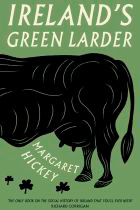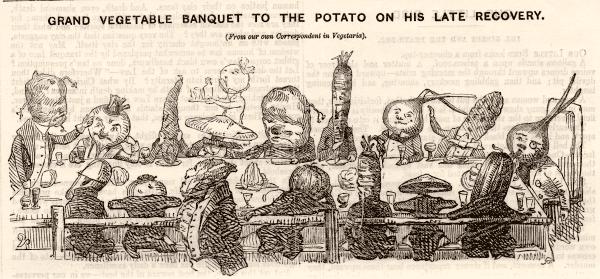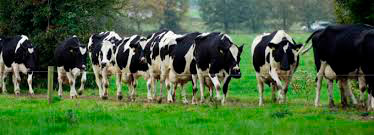Assessments of Ireland’s Green Larder by Margaret Hickey (London 2018)

1. Unbound illuminatti.
Ireland’s Green Larder by Margaret Hickey comes from Unbound, the London publisher crowdfunded by readers. Hickey has been a fixture in the food writing world for a long time. As the blurb on the book’s dust jacket explains, she has been the food and drink editor at Country Living and has written for prestigious papers including the Financial Times , Guardian and Times of London.
Hickey therefore has had no trouble attracting backers. They include Darina Allen, influential cookbook author and proprietor of the Ballymaloe Cookery School; Fiona Beckett, author of some two dozen books on food and wine; Patrick Chapman, Irish poet and screenwriter; Peggy Fallon, another prolific cookbook author; Sue Lawrence, celebrated Scottish food writer; and many others.
Allen considers the Green Larder a “work of considerable scholarship, enchantingly written in evocative prose.” Richard Corrigan, the Irish celebrity chef who has decamped to Mayfair, was not an investor but is another acolyte. In his introduction to the Green Larder , Corrigan describes it as “a history book with a few recipes included, it is lively and full of fascination” and is so extraordinary that it is “the only book on the social history of Ireland that you’ll ever need!” (Hickey back cover; “Introduction”)
This last will surprise academic historians of Ireland, but then the Green Larder does not target an academic audience. It has no footnotes or endnotes, nor does it provide citation to any of its many quotations. The cursory bibliography does not include most of the quoted sources; the titles of many do not appear in the text or anywhere else, which presents a problem because a number of the cited authors have written more than one book. It would be wonderful to know how to access the 1746 kitchen manuscript kept by Sarah Power, and to know something about her and her whereabouts, but Hickey offers neither citation nor guidance.
2. Irish wit.
Problems of citation aside, Hickey recounts some arresting passages and turns a few of her own. John Carr, an English visitor, wrote in 1805:
“So much do the Irish consider their own eggs to be superior for sweetness and flavour, that some Irishmen will not allow that an English hen can lay a fresh egg.” (Hickey 138)
“It is,” Hickey avers, “impossible to overestimate the importance of the pig in Ireland.” He was, to a tenant, “the little gentleman who pays the rent.” (Hickey 100)
Ducks, however, proved less popular due to their purported greed. “Look at the ducks,” an old woman in Hickey’s parish would exclaim, “the shovels on them! Ye’d never keep the food coming to them.” (Hickey 144)

Unpopular in early 19th c. Ireland….
Cork and its famed English Market have long been a center of good food in Ireland. “From the mid1760s,” for example, “Cork city became the most important centre for commercial butter production in the Atlantic world…. ” (Hickey 40)
Drisheen, an Irish variant of blood sausage, is particularly associated with Cork. The great English travel writer H. V. Morton recounts that when he requested drisheen at a Dublin hotel during the 1920s, the staff thought he
“was trying to be funny…. This drisheen, which looks like a large and poisonous snake, is a native of Cork…. Superior Dubliners pretend that it bites…. But drisheen is above such low comment: one might call it the caviare of Cork.” (Hickey 122)
A butcher in twenty-first century County Cork posts the sign “Pig’s trotters. Very low mileage.”
On the subject of drink, Hickey “once heard it said that an Irishman would crawl over the naked bodies of ten beautiful women in order to get a bottle of whiskey.” Ironically enough, this chauvinist for all things Irish (but emphatically not for anything Anglo-Irish) muses that “[t]here just may be a grain of truth there.” (Hickey 269)
Hickey herself notes that the eighteenth century Irish “were positively Japanese in their dread of losing face.” (Hickey 103) In discussing the rural dislike of shellfish: “The Irish country kitchen that has seen an oyster or a crab” is, she explains, “a rare one and a quare one.” (Hickey 181)
3. Irish exceptionalism.
Hickey has unearthed some unlikely and interesting facts. The Irish esteemed ‘white meats,’ that is, dairy products as well as eggs--cheese, cream, milk, especially butter--more highly than other foodstuffs before the advent of the potato. Butter and eggs, like pork, were indispensable sources of cash for the peasantry as late as the nineteenth century.
In Ireland, “the savoury pie never caught on outside Dingle.” She does not know why. On other subjects she is certain. “I must,” Hickey insists, “demolish the notion that Catholics were obliged to eat fish on Fridays and other fast days--they were not.” She muses on an Irish anomaly: This traditionally devout people never developed “special food rites or pishogues associated with Christmas.” (Hickey 115, 154, 308) A pishogue, for the uninitiated, is a curative spell for either human or beast, or other magical vehicle for increasing agricultural yield and in particular butter or milk.
The foibles of other Irish foodways attract her attention, in particular the Irish aversion to so many things, like those oysters and crabs, celebrated everywhere else. “This ignorance and rejection of shellfish,” Hickey concedes, “is rare among rural communities elsewhere in Europe and is hard to fathom.” (Hickey 181)
“Puffins,” perversely enough, “were not deemed to be meat and could therefore be eaten with a clear conscience at times of abstinence.” (Hickey 147)
 AOK with the Irish.
AOK with the Irish.
The rural Irish traditionally refused to eat but a small subset of fruit and vegetables. A farmer might tend an apple or plum tree, and perhaps “a big clump of rhubarb” but in general “other fruits were seldom seen.” The variety of wild berries that proliferated in the countryside was “left to wither on the bush.” (Hickey 200) Nor did many Irish forage for the mushrooms that were plentiful in both field and forest. They disdain not only new potatoes but also all waxy varieties: “A strange thing in a nation of potato lovers is that Irish people truly value only one style of potato,” only the very large “ball of flour.” Outside the now nearly extinct Ascendancy nobody would eat game either. “I never tried it, venison,” Hickey’s father tells her, “I believe it is strong.” (Hickey 219, 240, 117)
More generally, “an aversion to anything except the plainest and most familiar of foods has taken hold of people. Even textures of food,” like the heft of jam instead of jiggly jelly, “can arouse disgust.” (Hickey 206)
With a nearly numbing repetition, Hickey blames all these food fears and foibles on either the landlords (cultivation of fruit or vegetables might be considered an ‘improvement’ that could trigger an increase in rent) or famine. Unlike other writers, however, she never refers to fish, forage, game or small potatoes (the starving peasantry resorted to harvesting them prematurely) as ‘famine foods.’ (Hickey 201-02, 240) In any event the explanation remains unconvincing.
4. A dearth of indigenous dishes.
Despite Hickey’s heroic effort to conjure an Irish culinary tradition, it is difficult not to conclude from the Green Larder that none has existed other than Ulster baked goods, a few creative uses for the potato (boxty ticks both those boxes), and a handful of plain dishes indigenous to Britain. While, for instance, Hickey considers both seed and simnel cake Irish, she concedes that both of them originated in England. This absence of a coherent culinary tradition at any appreciable scale sets Ireland apart from other western cultures. As Hickey does admit, Ireland never developed “an intricate national cuisine.” (Hickey 14)
The dearth of many recognizably Irish dishes in the Green Larder is to some extent exacerbated because Hickey is “principally concerned not with the doings of the more affluent Irish, but with those of the vast majority of the people…. ” (Hickey 69) The majority she assesses, however, excludes the considerable catholic middle class that lived in Dublin and to a lesser extent Cork.
When she does recount a Big House dinner served a few years following the famine, or rather quotes an irresistible passage from Somerville and Ross, it sounds like a scene similar to something we might expect of the lesser, if more than usually eccentric, English gentry:
“Detestable soup in a splendid old silver tureen that was nearly as dark in hue as Robinson Crusoe’s thumb; a perfect salmon, perfectly cooked, on a chipped kitchen dish; such cut glass is not easy to find nowadays; stew that… would burn the shell off an egg; and a bottle of port, draped in immemorial cobwebs, wan with age and probably priceless.”
Hickey also discusses the prosperous (and catholic) Dublin Christmas that Joyce describes in The Dead , set circa 1900. It might as accurately have been served in the London, Leeds or Manchester of its time; roast goose, a ham and spiced beef set out with an array of savory and sweet side dishes. (Hickey 126)
Although Hickey never says so, beyond the Big House and big city, Irish cooking could be both desultory and dire. Reflecting on his stay in Dundalk between the wars, the “tepid soup and carelessly cooked meat in so many Irish hotels” perplexed Morton. “There is,” he lamented, “absolutely no imagination in Irish cooking.” And yet, prefiguring the claims of Hickey: “The quality of the food is perfect. Where else do you get such butter, such fresh eggs, such bacon and such meat, and such vegetables straight from a garden?”
He found it mysterious, however, that in Ireland “these things become either definitely unpleasant or even uneatable after they have passed through a kitchen! Even potatoes, which are supposed to be an Irish speciality, are often either pounded into a watery mess or are just frankly objectionable.”
“I do not know,” he concedes in frustration, “whether there is an Irish school of cookery.” (Morton 309)

The Green Larder does not deliver on the claims of either Allen or Corrigan. Instead of providing any species of thoughtful social history, the book rehashes a simplistic, tired trope of Irish grievance. The overall effect inadvertently echoes The Poor Mouth , Flann O’Brien’s ruthless 1941 satire of the poor pitiful plundered Paddy school of sentimental Irish martyrdom.
The Irish do of course have legitimate historical complaints. As Morton reminded his fellow countrymen in 1930,
“if Ireland’s struggle had been staged elsewhere in Europe, and had the ruling race been French, Italian or Turkish, no greater sympathy, no deeper indignation and no more eager support would have been forthcoming than that of England. Byrons in great numbers would have gone out in support of her national ideals.”
Then again, he also found the Irish unfair due to “the fact that they possess no sense of historical perspective.” The result:
“Even educated Irishmen will talk about Cromwell’s campaign as though it was the work of the present British Government. A wrong has never died in Ireland. Every injustice inflicted on Ireland since the time of Strongbow is as real as last year’s Budget.” (Morton 18)
To some eyes, Hickey’s among them, nothing has changed, and she takes every opportunity to decry ‘English’ policies and attitudes. To this end she tends to identify as English the travelers or commentators with an unfavorable or unfair view of Ireland while overlooking the nationality of favorable observers like Morton and others.
The canned, reflexive nature of Hickey’s shallow stabs at historical analysis presents the more fundamental problem with the Green Larder. “Certain people in authority,” she intones, “did not see starvation in Ireland as an altogether bad thing.” Her source, rather than anyone ‘in authority,’ is an unidentified newspaper correspondent who wrote with hyperbole of the Land War in 1886, some four decades following the actual famine, that Ireland “was being starved into improvements.” From the statement Hickey infers that his “unwritten coda is ‘and a good thing too.’” (Hickey 9-10) By then, however, the resistance of the Land League to callous landlords and indeed to the entire system of land ownership was in full sway and the agitation, among other things including the statutory intervention of the British government, had improved the plight of many tenants.
Hickey makes the unequivocal claims that landlords always racked rents, and if a tenant “fell into arrears there was no doubt at all he would be evicted.” (Hickey 254) In fact customary practice varied by estate and by region, and there was considerable doubt that a tenant in arrears would be evicted, as a number of historians including L. P. Curtis, Jr., James Donnelly, Terence Dooley, W. E. Vaughan and others--none of them Ascendancy apologists--have demonstrated.
“On some estates,” Vaughan explains, “arrears of two or three years were tolerated during hard times” and by the mid-Victorian era “the threat of eviction was not decisive.” (Vaughan 33) Donnelly concurs. He adds that on the sprawling estates of the Duke of Leinster rents were reasonable and arrears of over two years were not uncommon. (Donnelly 200-05)
6. A woman of multiple minds.
Repetition is rife, while any number of errors compound the lack of thoughtful historical perspective. Repeated reference to “the national genius” and “the Irish national genius” extols the mundane with a whiff of contradiction. Hickey blames a traditional “hand-to-mouth” subsistence economy for abject poverty and, incidentally, “the lack of invention in traditional Irish cooking,” but also proudly concludes that it “suited the national genius that is uncomfortable with too much organisation.” (Hickey 92, 10)

Notwithstanding her depiction of Irish farmers as universally destitute, she does concede that an eighteenth century “boom in dairying…. did create a solid farming class.” (Hickey 40-41)
At the same time as “the knack of enjoying fish is one that few Irish people ever really acquired…. the bounty of the sea, the shore, the river and the lake were not totally ignored. Far from it.” (Hickey 147, 150) Which, the reader understandably would wonder, is it?
These are not isolated examples. The argument that memory of the famine accounts for the historically monotonous Irish diet reappears at regular intervals.
At page 83, Hickey asserts that “porter” is “no longer available; instead we have to use stout, a stronger version of porter;” then, at page 277: “Porter” is “no longer brewed.” In fact stout may be weaker than porter; for much of Irish history the terms have been synonymous; Fullers of London never ceased production; Guinness alone bottles two porters, its West Indian and Dublin versions, both of them available on tap in Dublin; and hundreds of craft brewers in Ireland, Britain and North America brew any number of porters.
More generally the entire sections devoted to drink, perhaps the only manifestation of a developed Irish culinary culture, are selective, slapdash and shallow.
7. You call that coddle?
Most inexcusable of all, Hickey appears never actually to have encountered Dublin coddle. She claims it always is “made with streaky smoked bacon,” but uncured Irish bacon from the leaner loin is the norm, and Dubliners most certainly do not, as she maintains, prefer their coddle constructed without the essential potato, as the most cursory glance at any number of cookbooks and online entries indicates. (Hickey 118)
8. Last and first lines.
Hickey concludes the Green Larder with one of the better examples of trite platitude. “Earth wind and fire,” she explains, “these are the primeval elements that run through the history of Ireland.”
In elaborating with sentimental silliness on this theme, universally applicable to any geographical region, she continues:
“The story of Ireland is ever a story of what grows on her soil, the creatures that live on her hills and in her waters and the work of human hands, passing life on to the next generation.”
It was, in Ireland, a dark and stormy night….
To close the circle, in retrospect this kind of thing should have been predictable. Hickey chose to begin the Green Larder with one of the more tired and tiresome quotations in all literature. “Tell me what you eat,” Brillat-Savarin demanded, “and I will tell you what you are.” (Hickey 1) The argument, advanced as it is by a French person, may be less applicable as a matter of tradition to Ireland than just about any other place.
More generally it would be prudent to guard against any author’s tendency to overestimate the importance of her topic. Steven Poole could have been considering the Irish when he entitled his polemic against the pretenses of culinary commentary and practice:
“You aren’t what you eat.”
Sources:
James Donnelly, The Land and the People of Nineteenth-Century Cork (London 1975)
Terence Dooley, The Decline and Fall of the Dukes of Leinster, 1872-1948 (Dublin 2015)
H. V. Morton, In Search of Ireland (London 1930)
Blake Perkins, “A note about Dublin coddle,” www.britishfoodinamerica.com No. 26 (March 2012)
“A note on Ascendancy foodways with a digression on Irish stew and a short detour to Boston,” www.britishfoodinamerica.com No. 36 (Spring 2013)
“Is there an Irish cuisine?” www.britishfoodinamerica.com No. 26 (March 2012)
Steven Poole, You Aren’t What You Eat (London 2012)
W. E. Vaughan, Landlords and Tenants in Mid-Victorian Ireland (Oxford 1994)

